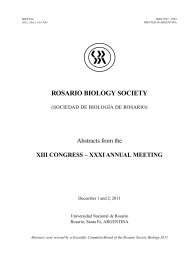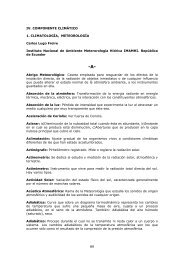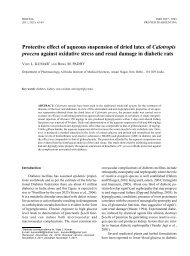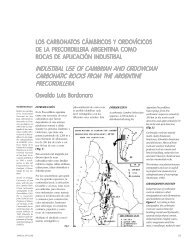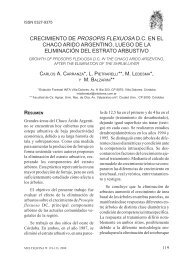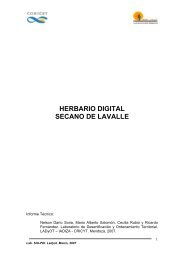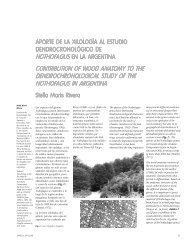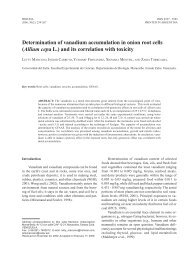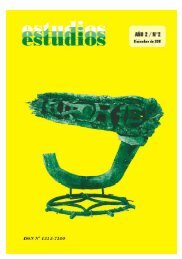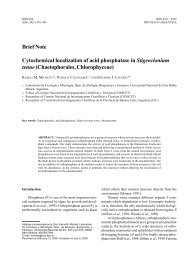XXII Annual Scientific Meeting, Tucuman Biology Society ...
XXII Annual Scientific Meeting, Tucuman Biology Society ...
XXII Annual Scientific Meeting, Tucuman Biology Society ...
Create successful ePaper yourself
Turn your PDF publications into a flip-book with our unique Google optimized e-Paper software.
188 ABSTRACTS<br />
89.<br />
ANTIMICROBIAL EFFECT OF XENOPHYLLUM POPOSUM<br />
ON ACTINOMYCES NAESLUNDII<br />
Torres S, Tracanna MI, Amani S, Poch M, Cárdenas L, Ferro M,<br />
Gutiérrez S.<br />
Microbiology Dept., Fac. of Dentistry. Farmacognosy Dept.,<br />
Bioqca, Fac. UNT. Av. Benjamín Araoz 800. C. P: 4000. Tucumán.<br />
E-mail: sofiatorresar@yahoo.com.ar<br />
The control of dental caries involves the mechanic elimination of<br />
dental plaque with the use of antimicrobial agents. The inhibition<br />
of Actinomyces naeslundii, associated to this disease, due to<br />
ethanolic extract of Xenophyllum poposum was demonstrated by<br />
our laboratory. The aim of this work was to determine the Minimum<br />
Inhibitory Concentration (MIC) and Minimum Bactericide<br />
Concentration (MBC) of the ethanolic extract of X.poposum on<br />
A.naeslundii. Dilutions of 1%, 5%, 10% and 20% of extract were<br />
assayed. DO 560 nm at 0, 24 and 72 h was determined and the count of<br />
colonies in Thioglycolate Agar was made to determine MBC. All<br />
the tests were made by duplicate.<br />
Results:1) The MIC of the extract in study was 10%. 2) The MBC<br />
was 10%.<br />
Conclusions: The determination of MIC and MBC of the ethanolic<br />
extract in study is important to control of A. naeslundii. Alternative<br />
therapies must keep in mind the ecological aspects of oral cavity<br />
to maintain the balance of the total microbiota in mouth.<br />
Subsidized by the Research Council of UNT and Laboratory NAF<br />
90.<br />
EVALUATION OF INFECTION CONTROL IN STUDENTS<br />
OF FAC. OF DENTISTRY. UNT<br />
Granillo BA, Annan MS, Benito de Cárdenas IL.<br />
Microbiology Dept. Fac. Of Dentistry. UNT. Benjamín Araoz 800.<br />
San Miguel de Tucumán. E-mail: granillo@arnet.com.ar<br />
It is necessary to standardize the preventive measures inside the<br />
Program of Infection Control in Faculty of Dentistry. The objective<br />
of this work was to evaluate through questionnaires to students<br />
of Fac. of Dentistry-UNT, on knowledge and application of<br />
the norms of infection control.<br />
It was compared to students’ groups according to time of coursed in<br />
Microbiology. A multiple and anonymous survey of questions was<br />
designed. Results: 53% is immunized for HVB; 93% uses physical<br />
barriers; 86% make a correct sterilization; 67% recognizes the importance<br />
of the handwashing; 87% assumes that the all healthcare is<br />
responsible in the prevention of cross-infections. We empathize the<br />
percentage of negative answers: 73% doesn’t carry out disinfection<br />
of surfaces; 76% doesn’t purge the pipes of the dental water lines;<br />
and 50% not know the measures in postexposure accidents.<br />
Conclusions: The students know the risks to those that are exposed<br />
in the clinic. It should be carried out monitoring and surveillance<br />
in the clinical practices, immunization for HVB and to insist in the<br />
Prevention Postexposure.<br />
Supported by CIUNT.<br />
BIOCELL 30(1), 2006<br />
91.<br />
COMPARATIVE STUDY BETWEEN PLANT EXTRACTS<br />
(CAESALPINIA PARAGUARIENSIS) WITH ANTIBACTE-<br />
RIAL ACTIVITY AND SYNTHETIC ANTIBIOTICS OF<br />
FREQUENT APPLICATION IN ANTIINFECTION THERAPY<br />
Sgariglia MA, Soberón JR, Quiroga EN, Vattuone MA.<br />
Cátedra de Fitoquímica. Instituto de Estudios Vegetales “Dr. Antonio<br />
R. Sampietro”. Facultad de Bioquímica, Química y Farmacia.<br />
UNT. Ayacucho 471. (4000) S.M. de Tucumán. Argentina. E-mail:<br />
instveg@unt.edu.ar<br />
The aim of this study was the evaluation of the in vitro antibacterial<br />
activity of Caesalpinia paraguariensis extracts (Infusion, Decoction<br />
and Tincture) against 22 bacteria. This activity was compared<br />
with that of synthetic antibiotics. Synthetic drugs: Amoxicillin<br />
and Ciprofloxacin, were chosen taking into consideration their antibacterial<br />
spectrum, action mode and mechanisms, theirs frequency<br />
of use as therapeutic indication. Streptomycin sulphate, an ample<br />
spectrum antibiotic, was employed to compare the plant pathogenic<br />
action. We determined MICs and MBCs by broth microdilution<br />
method, and agar dilution method respectively (Muller Hinton<br />
medium). Although plant extracts and synthetic drug MICs and<br />
MBCs are not comparable from a quantitative point of view, some<br />
strains were sensible to the assayed extracts and simultaneously<br />
resistant to synthetic antibiotics. Moreover, we will use them as<br />
reference in the bioactivity-guided purification process.<br />
92.<br />
ANTIBACTERIAL ACTVITY OF CAESALPINIA<br />
PARAGUARIENSIS EXTRACTS<br />
Sgariglia MA, Soberón JR, Quiroga EN, Vattuone MA.<br />
Cátedra de Fitoquímica. Instituto de Estudios Vegetales “Dr. Antonio<br />
R. Sampietro”. Facultad de Bioquímica, Química y Farmacia.<br />
UNT. Ayacucho 471. (4000) S. M. de Tucumán. Argentina. E-mail:<br />
instveg@unt.edu.ar<br />
The ethnomedicinal use of plants reveals their importance as source<br />
of bioactive compounds and orients us toward the search of new<br />
substances with potential therapeutic applications. The objective<br />
of this study was to validate the antibacterial (AB) activity of extracts<br />
of a native species of Argentinean North, used in popular<br />
medicine as vulnerary. Guayacán (Fabaceae) bark extracts (Infusion<br />
(I), Decoction (D) and Tincture (T)), according Argentine Pharmacopoeia<br />
VI Ed., were assayed against 22 bacteria: Gram (+) and<br />
Gram (-) isolated from superficial wounds, ATCC and plant pathogenic<br />
bacteria (CECT). Broth microdilution and agar macrodilution<br />
techniques were employed in Muller Hinton (MH) medium. MIC<br />
and MBC values were determined. All tests were performed by<br />
quadruplicate. The extracts have a wide antibacterial activity, showing<br />
an evident growth inhibition and bacterial death on all the assayed<br />
strains. MIC values of I and D were 20-300 and 24,9-398,7<br />
μg. Extracted Material / 100 μl, respectively, that are higher than T<br />
AB activity (20-650). MBC values were coincident or higher than<br />
MIC values.



